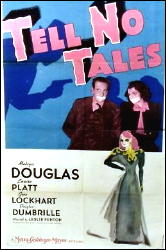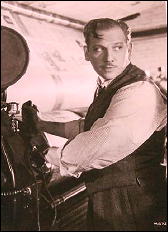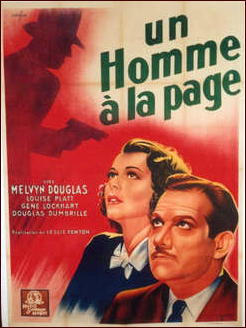Tue 8 Mar 2011
A Movie Review by David L. Vineyard: TELL NO TALES (1939).
Posted by Steve under Mystery movies , Reviews[4] Comments
TELL NO TALES. MGM, 1939. Melvyn Douglas, Louise Platt, Douglass Dumbrille, Gene Lockhart, Zeffie Tilbury, Sara Haden, Florence George. Screenplay: Lionel Houser. Director: Leslie Fenton.

Terrific two-fisted programmer from MGM that moves like an express and has a surprising amount of heart as well as brains. Douglas is Michael Cassidy, the editor of the Evening Standard, a big city newspaper about to be shut down by publisher Matt Cooper (Douglass Dumbrille) in favor of the tabloid rag he uses as his mouthpiece.
When Cassidy stumbles on the story of the century, a hundred dollar bill that was part of a kidnap ransom shows up in his hands, he plans for the Standard to go out in a blaze of glory. Setting out to follow the trail of the wandering hundred dollar bill, he enlists the help of the only witness to the kidnapping, a feisty school teacher sick of being kept virtual prisoner by the police (Louise Platt).
Cassidy follows the trail of the bill from a mousy jeweler about to be married; to a society doctor and his cheating wife; to a the wake of a black boxer possibly killed for his involvement with the kidnappers; to an attractive singer at a police benefit (with half the cops in town looking for him), a surprising source; and finally a casino owned by Gene Lockhart who leads him to the kidnappers, but for deadly reasons of his own.

At each turn the screenplay is better than it needs to be, and the individual stories well drawn and handsomely shot, from the grieving widow of the boxer (the Alley Kid); to the frightened look on the doctor’s wife’s face when cornered about her lie; to a nicely sinister bit by Lockhart as the casino owner. Zeffie Tilbury is particularly good as a tough old lady copy editor who has been with the paper fifty years and known Cassidy since he was a copy boy.
The finale is a bang up escape from the two kidnappers by Douglas and Platt, and a nicely rounded up ending, that, if a bit more upbeat and happy than the rest of the film would suggest, still leaves you more than well satisfied.
I first heard about this from William Everson’s The Detective Film, and it is every bit as good as promised: a mix of tough guy dialogue, two fisted journalism, solid detective work, and sentiment that is just the right combination of schmaltz and cynicism that might have come out of Black Mask or Dime Detective, and the kind of stories about two-fisted reporters that Nebel, Sale, Babcock, and Coxe specialized in.
Next time this shows up on TCM, be sure and catch it. It’s as slick as any A-film, and packs as much in sixty nine minutes as most A-films did in films half again as long.
Tremendous pace, sharp crackling dialogue, affecting vignettes by great character actors, and a pretty good mystery that unfolds on the run, this one can hold its own against many a bigger picture that doesn’t have half its heart or head.

March 9th, 2011 at 12:24 am
Not a movie I knew about before today, but now, strangely enough, it’s a must-have.
Not one so easily found, though, but if it’s been on TCM, findable it has to be.
You had me, David, when you mentioned Black Mask and Dime Detective, and I was solidly hooked when you slipped in names like Nebel, Sale, Babcock, and Coxe.
My kind of movie, obviously.
March 9th, 2011 at 12:18 pm
Everson had really nice things to say about it in his book, and when I finally found it (twenty years later) I was gratified to discover he was right.
It’s one of those smart tightly written little B films (and MGM’s B’s were as classy as some studios A films) that clicks along rapidly and is much better written and directed than you might expect (Fenton was a good director, doing one of my favorite westerns, THE REDHEAD AND THE COWBOY with Glen Ford and Rhonda Fleming from a Jonathan Latimer script).
Douglas is perfect for the fast talking tough newspaper editor with ink instead of blood in his veins and Dumbrille good in a slick role that lets him play a little deeper than just a bad guy.
The scene at the wake for the black boxer is especially evocative and handled with dignity (Douglas does use the term ‘boy’ to refer to the boxer, but ‘boy’ in this case was not the racial diminutive, but a common term used to refer to sports figures and particularly boxers of all races at the time as in “our boy Dempsey.”). His scene with the boxer’s grieving widow could have come right out of Chandler or Hammett and feels real and not contrived. It would have been a remarkable scene in an A film, it is practically unheard of in a B.
Each of the little vignette’s as Douglas follows the trail of the bill are well done and each goes a little deeper into character than it has to just to move the plot along.
Watch particularly for the scene with Gene Lockhart as the owner of the illegal casino. Lockhart is clearly enjoying getting to sink his teeth into a part, and plays it interestingly along Sydney Greenstreet lines (and before Greenstreet came along). It’s clear enough watching that scene that someone was familiar with Hammett and the hard boiled style.
Best of all you don’t have to make any excuses to enjoy this one. It’s first rate on all counts down to little details like getting the final extra out by just resetting the paper from the day before but with a new front page.
Someone will invariably call it noir, and it isn’t. It may prefigure some noir elements (that wake and the scene with Lockhart), but it is more BLACK MASK or DIME DETECTIVE than noir. And anyway Douglas Michael Cassidy is much too normal and adjusted to be a noir hero. I wouldn’t even call it proto noir, just a slick, smart, tough B mystery.
And re Everson’s book, I don’t think in all the years I’ve spent tracking down the films he recommends that I’ve ever been disappointed by one of them. It and Tuska’s THE DETECTIVE IN HOLLYWOOD were my Bibles for hunting down great detective movies.
March 10th, 2011 at 12:50 pm
Yeah, I remember reading Everson’s comments on this, and he was quite right: definitely a classy item.
What struck me was the opening scene where they establish Douglas’ character by having him throw a party for a worker who deseves some celebration/appreciation (this requires a big set and lots of extras.) If this had been a Warner’s “B” he would have punched out a chiseler; if it’d been a Monogram, we would have sen a montage of headlines about him solving cases and doing other exciting things too expensive to show.
March 10th, 2011 at 11:41 pm
Dan
That’s Zeffie Tilbury that Douglas character throws the party for and as you say it is a nicely handled scene that also shows the money MGM had and was willing to throw into a B movie. There are quite a few extras in the scene at the charity perfomance for the police too.
In fact in general this one has A production values (not unsual at MGM), with some care taken with sets and lighting (the scene at the wake looks very natural) and the script shows some thought put into it — it flows logically, and the one place where it could have been weak (Douglas convincing the teacher to leave police protection and join him) is smoothed over by the fact the actions fit her character.
The ‘happy’ ending is a bit contrived, but audiences expected those, and it adds a Capraesque touch to the film that at least feels right.
As for Everson I don’t recall him ever leading me wrong — at least from that book. There are still some of them I haven’t tracked down yet, but over the years its been a reliable guide for the best the genre had to offer.